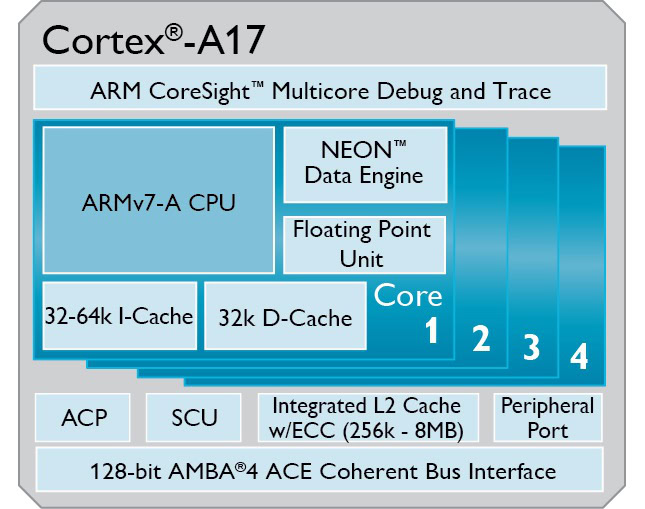Affiliate links on Android Authority may earn us a commission. Learn more.
ARM's new Cortex-A17 processor targets mid-range devices with clock speeds over 2GHz

Designed for a 28nm manufacturing process the Cortex-A17 can be used with ARM’s Mali range of GPUs including the Mali-T720. The Mali-T720, which was announced by ARM in October 2013, is some 300% faster than the Mali-400 GPU.
ARM see the Cortex-A17 as key in the rapidly growing mid-range smartphone and tablet market. “We expect to see a rich set of innovation in the mid-range mobile phone segment which is forecast to become a half a billion unit market annually from 2015 and the Cortex-A17 processor will be a key component in that growth,” said Ian Ferguson, vice president of segment marketing, ARM.
Technical bits
On paper the technical specification of the Cortex-A17 is:
- ARMv7-A 32-bit architecture
- Out-of-order CPUs with a 11+ stage pipeline
- Multicore 1-4X SMP within a single processor cluster
- Multiple coherent processor clusters through AMBA® 4 technology
- TrustZone® security technology
- NEON™ Advanced SIMD
- DSP & SIMD extensions
- VFPv4 Floating point
- Hardware virtualization support
- Large Physical Address Extensions (LPAE)
- Fused Multiply-Add extension
The Fused Multiply-Add extension (Fused-MAC) is a mathematical extension that provides instructions to perform multiply and accumulate operations in a single rounding step, making them more accurate. Fused-MAC is also found in the Cortex-A15. Related to Fused-MAC are the NEON instructions that are used to accelerate multimedia program such as video decoding and speech processing. The DSP & SIMD extensions increase the DSP processing capability of the CPU and are used for things like Voice over IP (VOIP) as well as in video & audio codecs. TrustZone is a security related technology that is used in a range of applications including digital rights management and electronic payments.
Because the Cortex-A17 uses the same ARMv7A architecture as the other Cortex designs, it is fully software compatible with existing software and will support Android and Linux right out of the box.
What we can expect
Several of ARMs partners are already pledging support for the Cortex-A17. ARM is ready to license the Cortex-A17 including all of the information need to actually make physical chips using a 28nm process technology.
“Realtek sees the Cortex-A17 processor as continuing the ARM track record of delivering the right balance of performance and power to address the demand for new products,” said Jessy Chen, Executive Vice President of Realtek.
Ker Zhang, Chief Executive Officer of VIA Telecom, said that VIA was “well-positioned to leverage the mid-range mobile devices opportunity with the ARM Cortex-A17 processor.”
MediaTek will also be using the Cortex-A17 and has already announced the MT6595 with four Cortex-A17 and four Cortex-A7 CPUs, however not with a Mali GPU but rather a PowerVR Series6 GPU. “The new ARM Cortex-A17 processor combines high performance with cost and efficiency, delivering an excellent user experience and a premium feature set, making it the best processing option available to continue our success in the mobile market,” said Johan Lodenius, chief marketing officer, MediaTek.
What do you think, at 60% faster than the Cortex-A9 but probably not as battery hungry as the Cortex-A15, could the new Cortex-A17 be a winner in the mid-range?